Unit 6 In a nature park 表格式教案(6个课时)
文档属性
| 名称 | Unit 6 In a nature park 表格式教案(6个课时) | 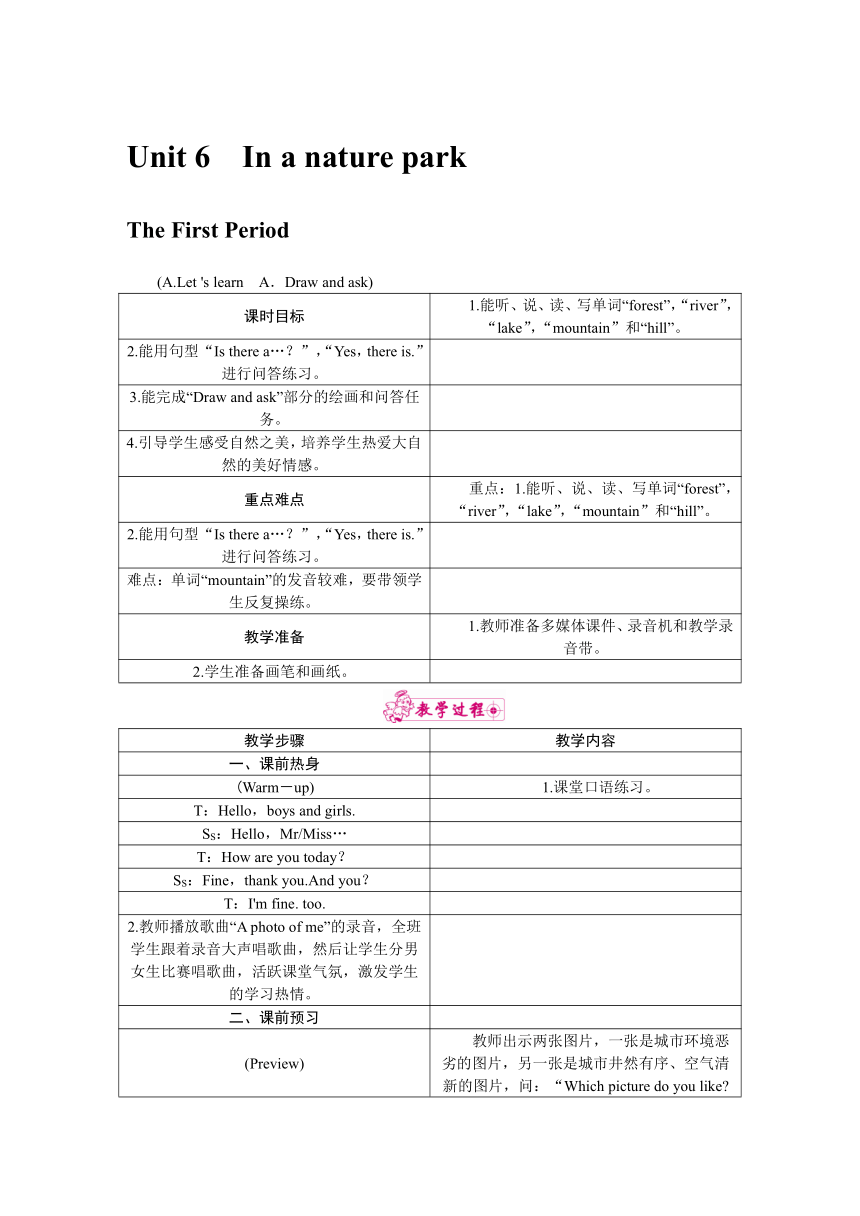 | |
| 格式 | zip | ||
| 文件大小 | 75.2KB | ||
| 资源类型 | 教案 | ||
| 版本资源 | 人教版(PEP) | ||
| 科目 | 英语 | ||
| 更新时间 | 2017-09-13 09:38:14 | ||
图片预览

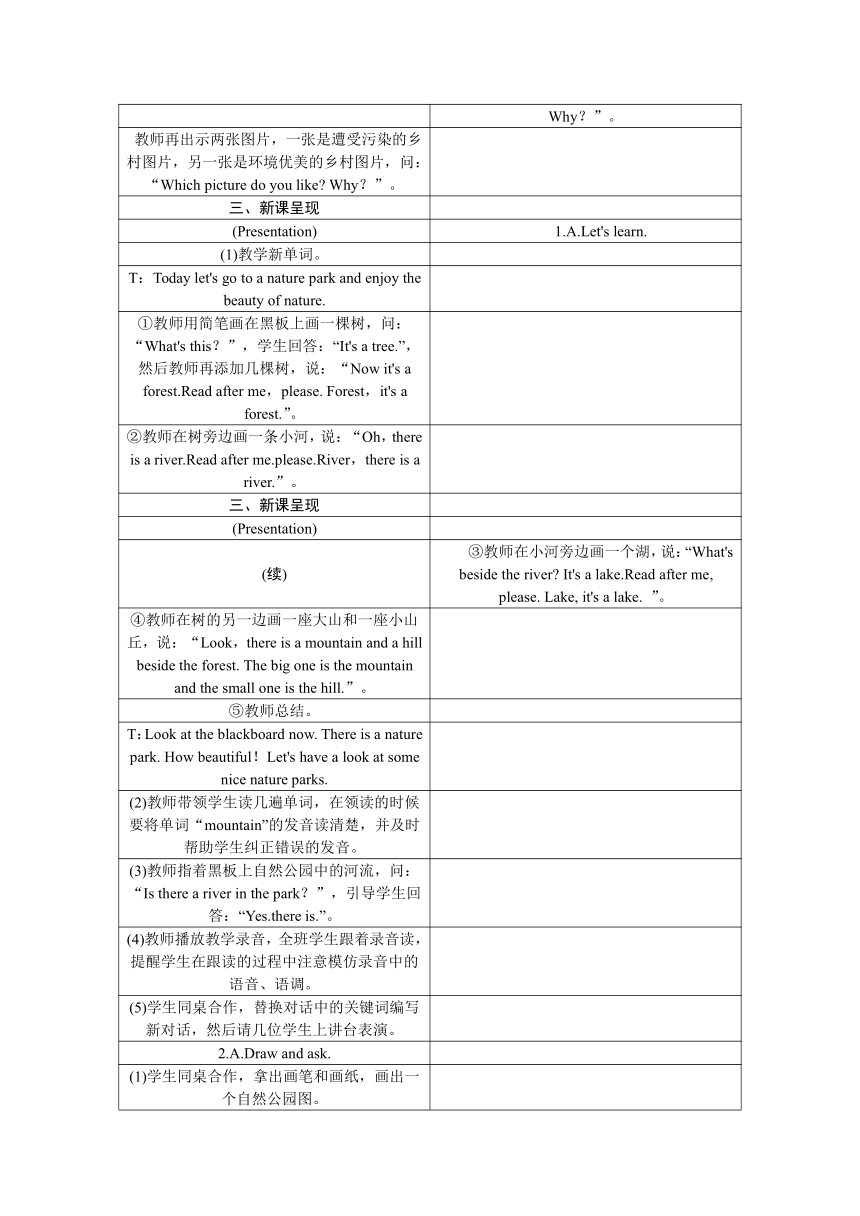
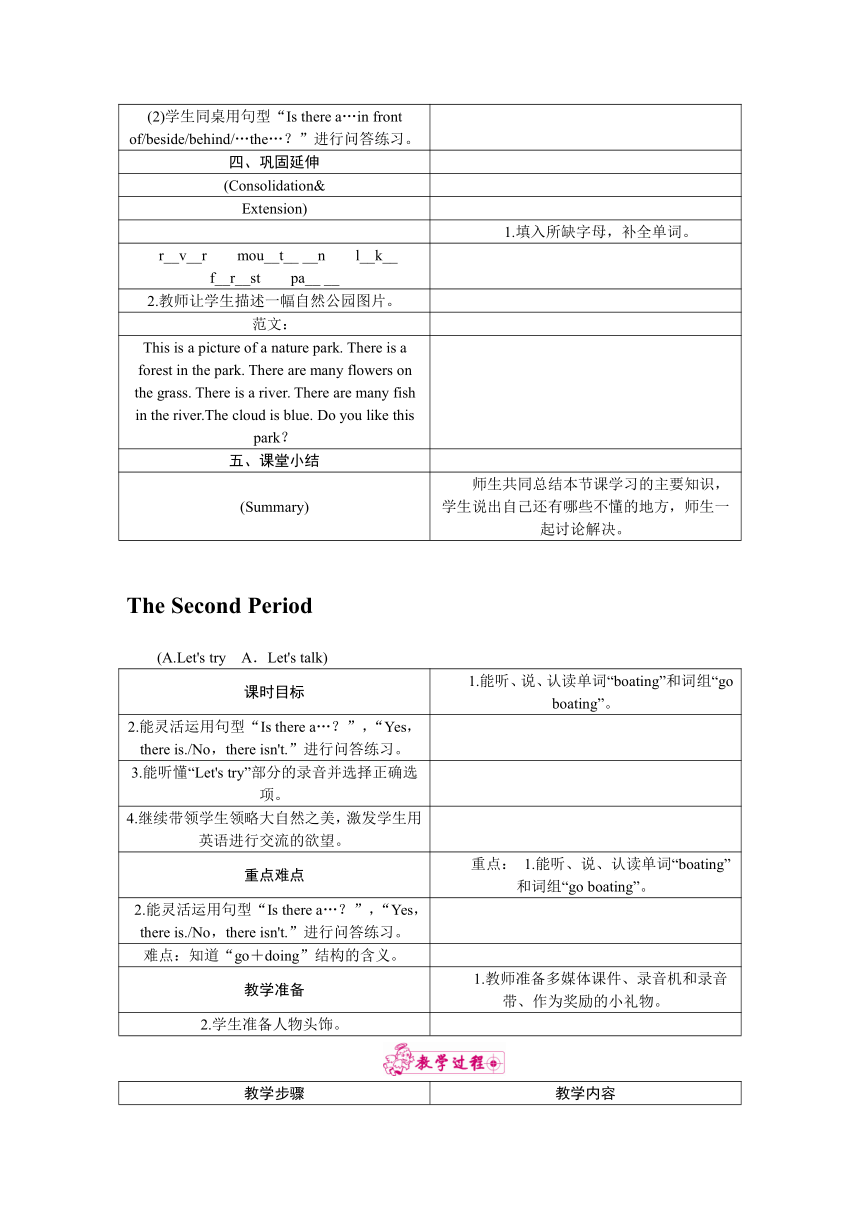
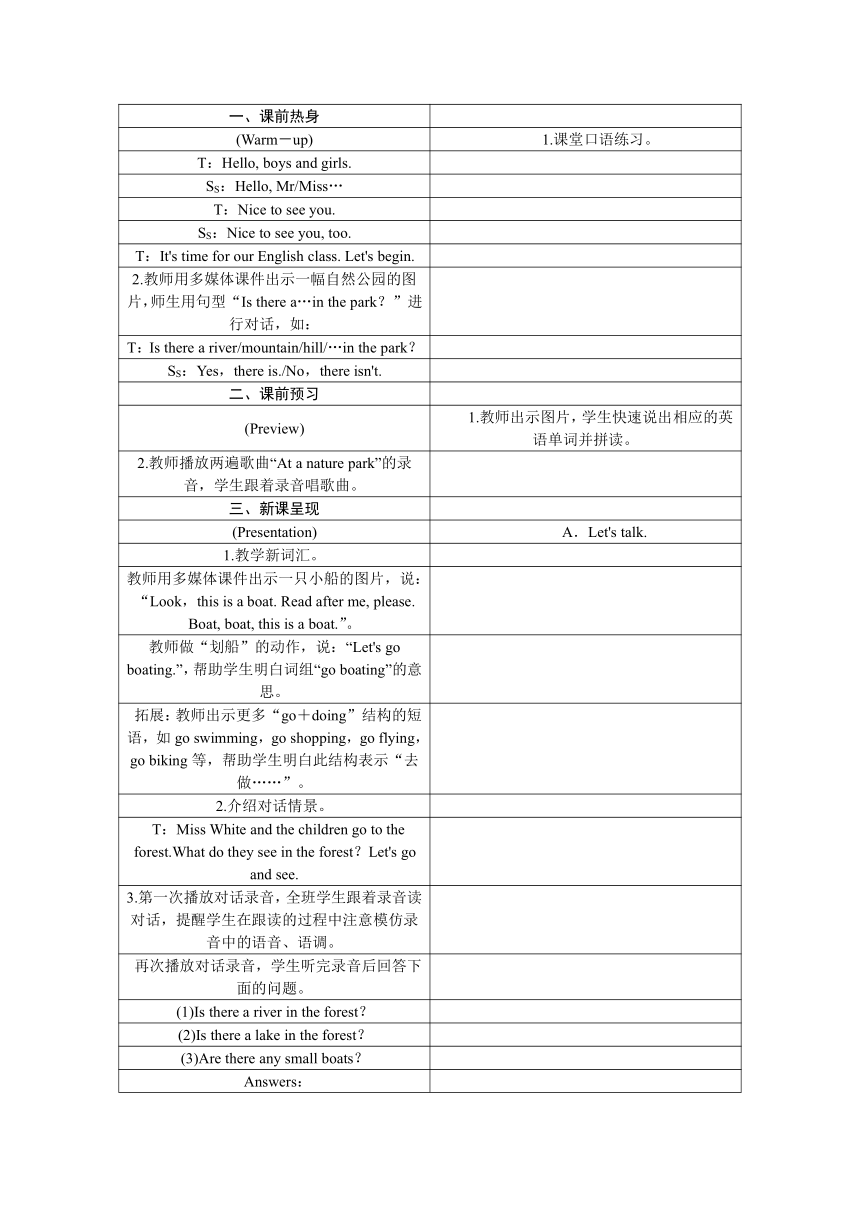
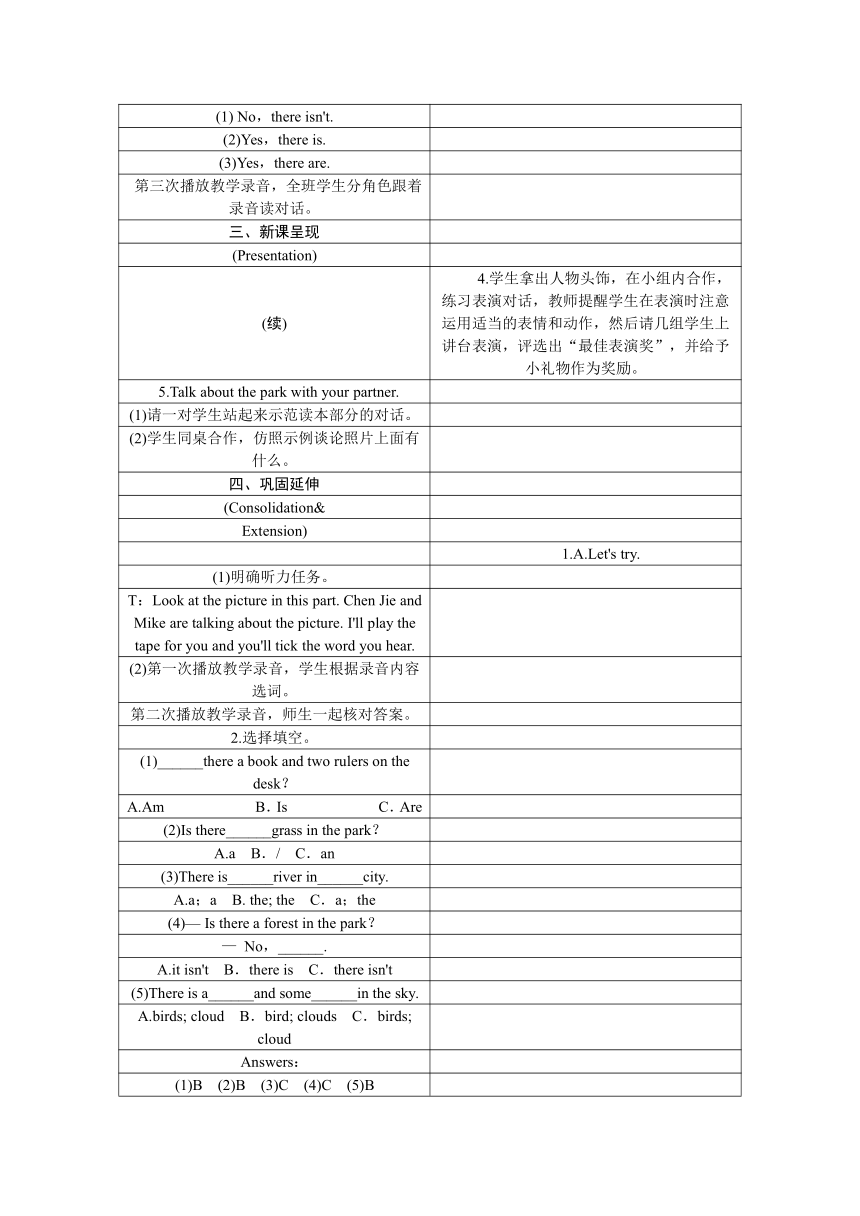
文档简介
Unit
6 In
a
nature
park
The
First
Period
(A.Let
's
learn A.Draw
and
ask)
课时目标
1.能听、说、读、写单词“forest”,“river”,“lake”,“mountain”和“hill”。
2.能用句型“Is
there
a…?”,“Yes,there
is.”进行问答练习。
3.能完成“Draw
and
ask”部分的绘画和问答任务。
4.引导学生感受自然之美,培养学生热爱大自然的美好情感。
重点难点
重点:1.能听、说、读、写单词“forest”,“river”,“lake”,“mountain”和“hill”。
2.能用句型“Is
there
a…?”,“Yes,there
is.”进行问答练习。
难点:单词“mountain”的发音较难,要带领学生反复操练。
教学准备
1.教师准备多媒体课件、录音机和教学录音带。
2.学生准备画笔和画纸。
教学步骤
教学内容
一、课前热身
(Warm-up)
1.课堂口语练习。
T:Hello,boys
and
girls.
SS:Hello,Mr/Miss…
T:How
are
you
today?
SS:Fine,thank
you.And
you?
T:I'm
fine.
too.
2.教师播放歌曲“A
photo
of
me”的录音,全班学生跟着录音大声唱歌曲,然后让学生分男女生比赛唱歌曲,活跃课堂气氛,激发学生的学习热情。
二、课前预习
(Preview)
教师出示两张图片,一张是城市环境恶劣的图片,另一张是城市井然有序、空气清新的图片,问:“Which
picture
do
you
like
Why?”。
教师再出示两张图片,一张是遭受污染的乡村图片,另一张是环境优美的乡村图片,问:“Which
picture
do
you
like
Why?”。
三、新课呈现
(Presentation)
1.A.Let's
learn.
(1)教学新单词。
T:Today
let's
go
to
a
nature
park
and
enjoy
the
beauty
of
nature.
①教师用简笔画在黑板上画一棵树,问:“What's
this?”,学生回答:“It's
a
tree.”,然后教师再添加几棵树,说:“Now
it's
a
forest.Read
after
me,please.
Forest,it's
a
forest.”。
②教师在树旁边画一条小河,说:“Oh,there
is
a
river.Read
after
me.please.River,there
is
a
river.”。
三、新课呈现
(Presentation)
(续)
③教师在小河旁边画一个湖,说:“What's
beside
the
river
It's
a
lake.Read
after
me,
please.
Lake,
it's
a
lake.
”。
④教师在树的另一边画一座大山和一座小山丘,说:“Look,there
is
a
mountain
and
a
hill
beside
the
forest.
The
big
one
is
the
mountain
and
the
small
one
is
the
hill.”。
⑤教师总结。
T:Look
at
the
blackboard
now.
There
is
a
nature
park.
How
beautiful!Let's
have
a
look
at
some
nice
nature
parks.
(2)教师带领学生读几遍单词,在领读的时候要将单词“mountain”的发音读清楚,并及时帮助学生纠正错误的发音。
(3)教师指着黑板上自然公园中的河流,问:“Is
there
a
river
in
the
park?”,引导学生回答:“Yes.there
is.”。
(4)教师播放教学录音,全班学生跟着录音读,提醒学生在跟读的过程中注意模仿录音中的语音、语调。
(5)学生同桌合作,替换对话中的关键词编写新对话,然后请几位学生上讲台表演。
2.A.Draw
and
ask.
(1)学生同桌合作,拿出画笔和画纸,画出一个自然公园图。
(2)学生同桌用句型“Is
there
a…in
front
of/beside/behind/…the…?”进行问答练习。
四、巩固延伸
(Consolidation&
Extension)
1.填入所缺字母,补全单词。
r__v__r mou__t__
__n l__k__ f__r__st pa__
__
2.教师让学生描述一幅自然公园图片。
范文:
This
is
a
picture
of
a
nature
park.
There
is
a
forest
in
the
park.
There
are
many
flowers
on
the
grass.
There
is
a
river.
There
are
many
fish
in
the
river.The
cloud
is
blue.
Do
you
like
this
park?
五、课堂小结
(Summary)
师生共同总结本节课学习的主要知识,学生说出自己还有哪些不懂的地方,师生一起讨论解决。
The
Second
Period
(A.Let's
try A.Let's
talk)
课时目标
1.能听、说、认读单词“boating”和词组“go
boating”。
2.能灵活运用句型“Is
there
a…?”,“Yes,there
is./No,there
isn't.”进行问答练习。
3.能听懂“Let's
try”部分的录音并选择正确选项。
4.继续带领学生领略大自然之美,激发学生用英语进行交流的欲望。
重点难点
重点:
1.能听、说、认读单词“boating”和词组“go
boating”。
2.能灵活运用句型“Is
there
a…?”,“Yes,there
is./No,there
isn't.”进行问答练习。
难点:知道“go+doing”结构的含义。
教学准备
1.教师准备多媒体课件、录音机和录音带、作为奖励的小礼物。
2.学生准备人物头饰。
教学步骤
教学内容
一、课前热身
(Warm-up)
1.课堂口语练习。
T:Hello,
boys
and
girls.
SS:Hello,
Mr/Miss…
T:Nice
to
see
you.
SS:Nice
to
see
you,
too.
T:It's
time
for
our
English
class.
Let's
begin.
2.教师用多媒体课件出示一幅自然公园的图片,师生用句型“Is
there
a…in
the
park?”进行对话,如:
T:Is
there
a
river/mountain/hill/…in
the
park?
SS:Yes,there
is./No,there
isn't.
二、课前预习
(Preview)
1.教师出示图片,学生快速说出相应的英语单词并拼读。
2.教师播放两遍歌曲“At
a
nature
park”的录音,学生跟着录音唱歌曲。
三、新课呈现
(Presentation)
A.Let's
talk.
1.教学新词汇。
教师用多媒体课件出示一只小船的图片,说:“Look,this
is
a
boat.
Read
after
me,
please.
Boat,
boat,
this
is
a
boat.”。
教师做“划船”的动作,说:“Let's
go
boating.”,帮助学生明白词组“go
boating”的意思。
拓展:教师出示更多“go+doing”结构的短语,如go
swimming,go
shopping,go
flying,go
biking等,帮助学生明白此结构表示“去做……”。
2.介绍对话情景。
T:Miss
White
and
the
children
go
to
the
forest.What
do
they
see
in
the
forest?Let's
go
and
see.
3.第一次播放对话录音,全班学生跟着录音读对话,提醒学生在跟读的过程中注意模仿录音中的语音、语调。
再次播放对话录音,学生听完录音后回答下面的问题。
(1)Is
there
a
river
in
the
forest?
(2)Is
there
a
lake
in
the
forest?
(3)Are
there
any
small
boats?
Answers:
(1)
No,there
isn't.
(2)Yes,there
is.
(3)Yes,there
are.
第三次播放教学录音,全班学生分角色跟着录音读对话。
三、新课呈现
(Presentation)
(续)
4.学生拿出人物头饰,在小组内合作,练习表演对话,教师提醒学生在表演时注意运用适当的表情和动作,然后请几组学生上讲台表演,评选出“最佳表演奖”,并给予小礼物作为奖励。
5.Talk
about
the
park
with
your
partner.
(1)请一对学生站起来示范读本部分的对话。
(2)学生同桌合作,仿照示例谈论照片上面有什么。
四、巩固延伸
(Consolidation&
Extension)
1.A.Let's
try.
(1)明确听力任务。
T:Look
at
the
picture
in
this
part.
Chen
Jie
and
Mike
are
talking
about
the
picture.
I'll
play
the
tape
for
you
and
you'll
tick
the
word
you
hear.
(2)第一次播放教学录音,学生根据录音内容选词。
第二次播放教学录音,师生一起核对答案。
2.选择填空。
(1)______there
a
book
and
two
rulers
on
the
desk?
A.Am B.Is C.Are
(2)Is
there______grass
in
the
park?
A.a
B./
C.an
(3)There
is______river
in______city.
A.a;a
B.
the;
the
C.a;the
(4)—
Is
there
a
forest
in
the
park?
—
No,______.
A.it
isn't
B.there
is
C.there
isn't
(5)There
is
a______and
some______in
the
sky.
A.birds;
cloud
B.bird;
clouds
C.birds;
cloud
Answers:
(1)B (2)B (3)C (4)C (5)B
五、课堂小结
(Summary)
师生一起总结本节课学习的主要内容,鼓励学生在日常生活中多用英语进行交流。
The
Third
Period
(B.Let's
learn B.Write
and
say)
课时目标
1.能听、说、读、写单词“tree”,“bridge”,“building”,“village”和“house”。
2.能用句型“Are
there
any…?”进行问答练习。
3.能完成“Write
and
say”部分的写作和说话任务。
4.教育学生要保护环境,热爱自己的家园。
重点难点
重点:1.能听、说、读、写单词“tree”,“bridge”,“building”,“village”和“house”。
2.能用句型“Are
there
any…?”进行问答练习。
难点:句型“Is
there…?”和“Are
there…?”的对比和应用。
教学准备
1.教师准备多媒体课件、录音机和录音带、挂图、图片。
2.学生准备画笔和画纸。
教学步骤
教学内容
一、课前热身
(Warm-up)
1.课堂口语练习。
T:Good
morning,
boys
and
girls.
SS:Good
morning,
Mr/Miss…
T:How
are
you
today?
SS:Fine,thanks.
T:Nice
to
see
you.
SS:Nice
to
see
you,too.
T:It's
time
for
our
English
class.
Here
we
go!
2.教师播放歌曲“At
a
nature
park”的录音,全班学生跟着录音唱歌曲,活跃课堂气氛。
二、课前预习
(Preview)
师生对话
。
T:Is
there
a
blackboard
in
our
classroom?
SS:Yes,there
is.
T:Is
there
a
car
in
the
classroom?
SS:No,there
isn't.
…
三、新课呈现
(Presentation)
1.B.Let's
learn.
(1)教学新单词。
①教学bridge。
教师出示一张自然公园的图片,图片中包含河流、河流上有桥、草、森林等景物。
T:Look
at
this
picture.
What
is
it?
SS:It
is
a
nature
park.
T:Yes.lt's
a
nature
park.What's
in
the
nature
park?(引导学生用“Is
there
a
forest/river…in
the
nature
park?”提问)
SS:Is
there
a…in
the
nature
park?
T:Yes,there
is./No,there
isn't.
T:It's
a
beautiful
nature
park
in
the
picture.
There's
a
forest,a
path
and
a
river
in
it.What's
on
the
river?
SS:It's
a
bridge.
教师带读bridge,并强调字母组合“dg”的发音。然后学生练读,并尝试用bridge造句。
②教学house。
教师出示一座房子的图片并引入单词house。然后教师领读house,并强调字母组合“ou”在此处的发音。
A.用以下方式练读。
House,house,I
have
a
small
house.
三、新课呈现
(Presentation)
(续)
House,house,it's
a
nice
house.
House,house,I
love
my
house.
B.教师出示较多的房子的图片并领读单词。
T:How
many
houses
are
there
in
the
picture?
引导学生用“There
are…houses
in
the
picture.”回答。
③教学village。
教师指着很多房子的图片,说:“Look!
It's
not
a
nature
park.
It's
a
village.”。
教师领读village,再出示一个小山村的图片(图片中包含trees,birds,
river等事物),问:“What
can
you
see
in
the
village?”。
引导学生用“There
are…in
the
village.”回答。
教师再出示两幅较为相似的village图片,问:“What's
the
difference
between
Village
A
and
Village
B?”,引导学生用“There
are…in
Village
A.There
are…in
Village
B.”回答。
④教学building。
教师出示一幢高楼的图片,问:“What
is
this?”,引出单词“building”。
教师领读building,并强调字母组合“ing”的发音,学生同桌练习读building。
⑤教师用多媒体课件出示森林的图片,说:“Look,this
is
a
forest.What's
in
the
forest
There
are
many
trees.”。
(2)教师出示本部分的教学挂图,介绍对话情景。T:Oliver
and
Wu
Yifan
are
in
a
village
now.
They
are
talking
about
the
things
in
the
village.
Let's
listen
to
the
tape
and
see.
(3)第一次播放本部分的教学录音,学生跟着录音读对话,提醒学生在跟读的过程中注意模仿录音中的语音、语调。
第二次播放教学录音,全班学生跟着录音分角色读对话。
(4)学生同桌合作,替换对话中的关键词重新编写对话,然后教师请两三对学生上讲台表演对话。
2.B.Write
and
say.
学生用There
be句型写四句话,介绍“Let's
learn”部分情景图中有些什么。
四、巩固延伸
(Consolidation
&
Extension)
1.学生拿出画纸和画笔,画一画自己理想中的自然公园。
2.教师请几位学生上讲台用There
be句型介绍自己的作品,其他学生用句型“Is/Are
there
any…?”问讲台上的学生。
五、课堂小结
(Summary)
师生一起总结本节课学习的词汇和句型,教师评价学生在课堂上的表现,鼓励学生多参与生活实践。
The
Fourth
Period
(B.Let's
try B.Let's
talk)
课时目标
1.能听、说、认读单词“nature”,“park,”和词组“nature
park”。
2.能灵活运用句型“Are
there
any…?”和“Yes,there
are.
/No,there
aren't.”进行问答练习。
3.能听懂“Let's
try”部分的录音并完成填空任务。
4.培养学生团结合作的精神和积极学习英语的态度。
重点难点
重点:1.能听、说、认读单词“nature”,“park”和词组“nature
park”。
2.能灵活运用句型“Are
there
any…?”和“Yes,there
are./No,
there
aren't.”进行问答练习。
难点:There
be句型的综合运用。
教学准备
1.教师准备多媒体课件、录音机和录音带。
2.学生准备人物头饰。
教学步骤
教学内容
一、课前热身
(Warm-up)
1.课堂口语练习。
T:Hello,
boys
and
girls.
Nice
to
see
you.
SS:Nice
to
see
you,
too.
T:How
are
you
today?
SS:Very
well,thanks.
2.教师播放歌曲“At
a
nature
park”的录音,全班学生分男女生比赛唱歌曲,创设良好的英语学习氛围。
二、课前预习
(Preview)
1.看谁记得快。
教师快速出示与上节课所学单词对应的图片,学生大声说出单词并集体拼读。
2.互通有无。
同桌合作,用句型“Is/Are
there…in
your
city/village?”进行问答练习。
三、新课呈现
(Presentation)
B.Let's
talk.
1.教学新词汇。
教师用多媒体课件出示自然公园的图片,引出词组“nature
park”。
2.教师播放本部分的教学录音,问:“Where
do
Miss
White
and
her
students
go?”,学生根据录音内容回答:“They
go
to
the
forest.”。
3.介绍对话情景。
T:There
is
a
nature
park
in
the
forest.
Now
Miss
White
and
Zhang
Peng
are
at
the
nature
park.
What
are
they
talking
about
Let's
listen
to
the
tape
and
see.
4.第一次播放对话录音,全班学生跟着录音读对话,提醒学生在跟读的过程中注意模仿录音中的语音、语调。
第二次播放对话录音,学生判断下面句子正误。
(1)The
nature
park
is
not
quiet.
(2)There
aren't
many
people
in
the
nature
park.
(3)There
are
some
tall
buildings
in
the
nature
park.
(4)There
aren't
any
animals
in
the
nature
park.
Answers:
(1)F (2)T (3)F (4)F
第三次播放教学录音,全班学生分角色跟着录音读对话。
三、新课呈现
(Presentation)
(续)
5.学生同桌合作,戴上人物头饰在小组内练习表演对话,教师提醒学生在表演时注意运用适当的表情和动作,然后请两三组学生上讲台表演,并评选出“最佳表演奖”。
6.Tick
a
picture
and
find
your“friend”.
(1)找两队学生站起来读一读本部分的两段对话。
(2)学生根据对话内容选择相应的图片,师生一起核对答案。
四、巩固延伸
(Consolidation&
Extension)
1.B.Lct's
try.
(1)介绍听力任务。
T:Listen
to
the
tape
and
try
to
find
out
where
are
the
tables.
(2)第一次播放教学录音,学生根据录音内容完成句子填空。
第二次播放教学录音,师生一起核对答案。
(3)根据汉语意思,完成下列句子。
①公园里有一个湖。
There
is
a______in
the______.
②村庄里有一条河吗?
______there
a______in
the
village?
③床头柜上有一面镜子吗?
______ ______a______on
the
end
table?
④城市里有许多高的建筑物吗?
Are
there______tall______in
the
city?
Answers:
①lake;park ②Is;river ③Is
there;mirror ④any;
buildings
五、课堂小结
(Summary)
师生一起总结本节课学习的词汇和句型,并让学生说说自己本节课的收获以及还有什么不懂的地方。
The
Fifth
Period
(A.Let's
spell B.Let's
wrap
it
up)
课时目标
1.通过大量的听读操练,学习双元音/au/在单词中的发音,提高学生对音标知识的综合运用能力和对知识的融合能力。
2.能完成“Let's
wrap
it
up”部分的任务,知道如何确定There
be句型的一般疑问句中be动词的单复数。
3.激发学生学习音标知识的兴趣。
重点难点
重点:1.通过大量的听读操练,学习双元音/au/在单词中的发音,提高学生对音标知识的综合运用能力和对知识的融合能力。
2.能完成“Let's
wrap
it
up”部分的任务,知道如何确定There
be句型的一般疑问句中be动词的单复数。
难点:使学生能准确发音,培养学生纠正错误发音的能力。
教学准备
教师准备多媒体课件、录音机和录音带、挂图。
教学步骤
教学内容
一、课前热身
(Warm-up)
1.课堂口语练习。
T:Good
morning,boys
and
girls.
SS:Good
morning,teacher.
T:Nice
to
see
you.
SS:Nice
to
see
you,too.
2.请一两对学生上讲台表演“B.Let's
talk”部分的对话。
3.全班学生一起跟着录音唱歌曲“At
a
nature
park”。
二、课前预习
(Preview)
猜一猜。
教师再出示一张自然公园挂图,让几个学生背对图片,用“Is
there
a…?”来提问,其他学生看图回答:“Yes,there
is./No,there
isn't.”。
三、新课呈现
(Presentation)
A.Let's
spell.
1.Read,
listen
and
chant.
(1)教师用多媒体课件依次出示本部分的图片,引出例词并将例词写在黑板上。
house mouse sound count
(2)教师播放两遍教学录音,学生跟着录音读例词;然后教师带领学生用“唱反调”的方式读几遍单词,纠正学生错误的发音。
(3)学生读顺口溜,练习例词发音。
There
is
a
mouse
in
the
house.
The
mouse
makes
some
sound.
Oh,
there
are
some
other
mice.
Let's
count.
(4)教师讲解发音要领:双元音/au/的发音和汉语中的“凹”相似,但是更夸张。先发/a/,然后滑向/u/音,嘴巴张大,一定要夸张。
(5)出示下面的句子,学生在练读过程中巩固双元音/au/的发音。
Never
doubt
yourself!永远不要怀疑自己。
Am
I
allowed
to
smoke
here?我可以在这里抽烟吗?
I
am
really
proud
of
my
daughter.我为我女儿感到骄傲。
Write
it
down
now.
Don't
rely
on
your
memory.
现在就写下来,不要依赖你的记忆力。(好记性不如烂笔头。)
I
don't
want
to
go
out.1
want
to
hang
around
the
house.
我不想出去,我只想待在家里。
2.Look,listen
and
circle.
(1)学生同桌相互读一读本部分的三组单词。
(2)第一次播放教学录音,学生根据录音内容圈出正确的单词。
第二次播放教学录音,师生一起核对答案。
3.
Look,listen
and
write.
(1)介绍任务。
T:There
are
three
pictures.Look
at
the
pictures
and
listen
to
the
tape.After
listening,you
should
complete
the
three
sentences
below
the
pictures.
(2)第一次播放教学录音,学生根据录音内容完成句子。
第二次播放教学录音,师生一起核对答案。
(3)学生选择自己喜欢的一句话并将其抄写在横线上。
四、巩固延伸
(Consolidation&
Extension)
B.Let's
wrap
it
up.
1.教师用多媒体课件出示本部分的教学挂图,介绍任务。
T:Look
at
the
picture.
You
should
complete
the
questions
and
give
your
answers.
2.师生用问答的方式核对答案。
3.教师总结There
be句型的一般疑问句的构成及意义。
(1)
There
be句型用来表示“某处有某人或某物”,其基本句型为“There
be+某人或某物十某地”,如:
There
are
a
lot
of
beautiful
flowers
in
the
garden.花园里有许多漂亮的花。
There
is
a
camera
on
the
fridge.冰箱上面有一部照相机。
(2)There
be句型变为一般疑问句,把be动词放在there的前面,be动词的首字母大写,句末用问号,如:
There
is
a/an/some…→Is
there
a/an/any…?
肯定回答:Yes,there
is.
否定答语:No,there
isn't.
There
are
some…→Are
there
any…?
肯定答语:Yes,there
are.
否定答语:No,there
aren't.
五、课堂小结
(Summary)
师生一起总结本节课学习的主要知识,教师评价学生在课堂上的表现。
The
Sixth
Period
(B.Read
and
write B.Let's
check C.Story
time)
课时目标
1.能完成“Read
and
write”部分的绘画和填空任务,复习本单元的主要词汇和句型。
2.能听懂“Let's
check”部分的录音并完成判断和回答问题的任务。
3.能听、说、认读单词“high”。
4.能读懂“Story
time”部分的趣味故事。
5.提高学生的英语阅读能力和学习英语的兴趣。
重点难点
重点:1.能完成“Read
and
write”部分的绘画和填空任务,复习本单元的主要词汇和句型。
2.能听懂“Let's
check”部分的录音并完成判断和回答问题的任务。
难点:提高学生综合运用英语知识的能力。
教学准备
1.教师准备多媒体课件、录音机和录音带、作为奖励的小礼物。
2.学生准备画笔和画纸。
教学步骤
教学内容
一、课前热身
(Warm-up)
1.课堂口语练习。
T:Hello,boys
and
girls.
SS:Hello,Mr/Miss…
T:How
are
you
today?
SS:Fine,thank
you.
T:It's
time
for
our
class.Let's
clap
our
hands
and
begin
our
class.
2.教师播放歌曲“At
the
nature
park”的录音,全班学生跟着录音唱歌曲,活跃课堂气氛。
二、新课呈现
(Presentation)
1.B.Read
and
write.
(1)教学新单词。
教师指着教室里的日光灯,说:“Oh,look
at
the
lights.They're
too
high.I
can't
touch
them.”,教师边说边做动作,帮助学生明白单词“high”的意思。
教师问:“What
is
high?”,学生回答:“The
sky/kite/building/…is
high.”。
(2)Read
and
draw.
T:Hello,everyone.It's
time
to
meet
our
friend,Robin.Now
Robin
is
at
Mr
Jones'house.What
can
the
robot
see?Let's
listen
to
the
tape
and
know
about
it.
(3)教师播放教学录音,学生根据录音内容回答问题。
①Where
is
Robin?
②What's
in
front
of
the
mountain?
③What's
on
the
lake?
Answers:
①He
is
at
Mr
Jones'
house.
②In
front
of
the
mountain,
there
is
a
small
village.
③There
are
many
ducks
on
the
lake.
(4)
Draw
a
picture
at
the
park.
学生自主阅读短文,根据短文的描述画出自然公园的图片,然后在六人小组内呈现自己画的图片,最后每个小组选出最好的一张图片,教师评选出“最佳小画家”,并给予小礼物作为奖励。
(5)Write
three
questions
about
the
nature
park
and
give
the
answers.
学生用There
be句型的一般疑问句写出问句,同桌合作进行问答练习。
2.B.Let's
check.
(1)介绍对话任务。
T:Listen
to
the
tape,tick
or
cross
the
pictures
and
answer
the
questions.
(2)第一次播放教学录音,学生根据录音内容判断图片正误。
第二次播放教学录音,学生根据录音内容回答问题。
第三次播放教学录音,师生一起核对答案。
三、巩固延伸
(Consolidation&
Extension)
C.Story
time.
1.教师依次出示本部分的教学挂图,学生根据挂图内容猜测故事大意。
2.教师播放本部分的教学录音,学生验证自己的猜测是否正确。
三、巩固延伸
(Consolidation&
Extension)
(续)
3.介绍故事背景。
T:Zoom
and
Zip
go
to
the
nature
park
on
a
nice
day.
What
will
happen?Let's
listen
to
the
tape
and
see.
4.第一次播放教学录音,全班学生小声跟着录音读,提醒学生在跟读的过程中注意模仿录音中的语音、语调。
第二次播放教学录音,学生听完录音后回答下面的问题。
(1)What
can
they
do
in
the
nature
park?
(2)What
are
beautiful,too?
(3)Are
there
any
people
in
the
house?
(4)What
do
they
do
first?
Answers:
(1)They
can
take
some
pictures.
(2)The
mountains
and
trees
are
beautiful,too.
(3)No,there
aren't.
(4)They
take
pictures
of
the
koala
first.
第三次播放教学录音,全班学生分角色跟着录音读对话。
5.学生同桌合作,练习分角色表演故事,然后教师请两三对学生上讲台表演,提醒学生表演时要带上适当的表情和动作,教师评选出“最佳表演奖”,并给予小礼物作为奖励。
四、课堂小结
(Summary)
师生一起总结本单元学习的词汇和句型。
词汇:forest,river,lake,mountain,hill,tree,bridge,building,village,house,boating,go
boating,nature
park,aren't,high
句子:
What's
in
the
park?
Let's
go
to
the
forest.
Are/Is
there…?
Yes,there
are/is./No,there
aren't/isn't.
Let's
go
boating.
The
nature
park
is
so
quiet.
There
is
a
nature
park
near
the
house.
6 In
a
nature
park
The
First
Period
(A.Let
's
learn A.Draw
and
ask)
课时目标
1.能听、说、读、写单词“forest”,“river”,“lake”,“mountain”和“hill”。
2.能用句型“Is
there
a…?”,“Yes,there
is.”进行问答练习。
3.能完成“Draw
and
ask”部分的绘画和问答任务。
4.引导学生感受自然之美,培养学生热爱大自然的美好情感。
重点难点
重点:1.能听、说、读、写单词“forest”,“river”,“lake”,“mountain”和“hill”。
2.能用句型“Is
there
a…?”,“Yes,there
is.”进行问答练习。
难点:单词“mountain”的发音较难,要带领学生反复操练。
教学准备
1.教师准备多媒体课件、录音机和教学录音带。
2.学生准备画笔和画纸。
教学步骤
教学内容
一、课前热身
(Warm-up)
1.课堂口语练习。
T:Hello,boys
and
girls.
SS:Hello,Mr/Miss…
T:How
are
you
today?
SS:Fine,thank
you.And
you?
T:I'm
fine.
too.
2.教师播放歌曲“A
photo
of
me”的录音,全班学生跟着录音大声唱歌曲,然后让学生分男女生比赛唱歌曲,活跃课堂气氛,激发学生的学习热情。
二、课前预习
(Preview)
教师出示两张图片,一张是城市环境恶劣的图片,另一张是城市井然有序、空气清新的图片,问:“Which
picture
do
you
like
Why?”。
教师再出示两张图片,一张是遭受污染的乡村图片,另一张是环境优美的乡村图片,问:“Which
picture
do
you
like
Why?”。
三、新课呈现
(Presentation)
1.A.Let's
learn.
(1)教学新单词。
T:Today
let's
go
to
a
nature
park
and
enjoy
the
beauty
of
nature.
①教师用简笔画在黑板上画一棵树,问:“What's
this?”,学生回答:“It's
a
tree.”,然后教师再添加几棵树,说:“Now
it's
a
forest.Read
after
me,please.
Forest,it's
a
forest.”。
②教师在树旁边画一条小河,说:“Oh,there
is
a
river.Read
after
me.please.River,there
is
a
river.”。
三、新课呈现
(Presentation)
(续)
③教师在小河旁边画一个湖,说:“What's
beside
the
river
It's
a
lake.Read
after
me,
please.
Lake,
it's
a
lake.
”。
④教师在树的另一边画一座大山和一座小山丘,说:“Look,there
is
a
mountain
and
a
hill
beside
the
forest.
The
big
one
is
the
mountain
and
the
small
one
is
the
hill.”。
⑤教师总结。
T:Look
at
the
blackboard
now.
There
is
a
nature
park.
How
beautiful!Let's
have
a
look
at
some
nice
nature
parks.
(2)教师带领学生读几遍单词,在领读的时候要将单词“mountain”的发音读清楚,并及时帮助学生纠正错误的发音。
(3)教师指着黑板上自然公园中的河流,问:“Is
there
a
river
in
the
park?”,引导学生回答:“Yes.there
is.”。
(4)教师播放教学录音,全班学生跟着录音读,提醒学生在跟读的过程中注意模仿录音中的语音、语调。
(5)学生同桌合作,替换对话中的关键词编写新对话,然后请几位学生上讲台表演。
2.A.Draw
and
ask.
(1)学生同桌合作,拿出画笔和画纸,画出一个自然公园图。
(2)学生同桌用句型“Is
there
a…in
front
of/beside/behind/…the…?”进行问答练习。
四、巩固延伸
(Consolidation&
Extension)
1.填入所缺字母,补全单词。
r__v__r mou__t__
__n l__k__ f__r__st pa__
__
2.教师让学生描述一幅自然公园图片。
范文:
This
is
a
picture
of
a
nature
park.
There
is
a
forest
in
the
park.
There
are
many
flowers
on
the
grass.
There
is
a
river.
There
are
many
fish
in
the
river.The
cloud
is
blue.
Do
you
like
this
park?
五、课堂小结
(Summary)
师生共同总结本节课学习的主要知识,学生说出自己还有哪些不懂的地方,师生一起讨论解决。
The
Second
Period
(A.Let's
try A.Let's
talk)
课时目标
1.能听、说、认读单词“boating”和词组“go
boating”。
2.能灵活运用句型“Is
there
a…?”,“Yes,there
is./No,there
isn't.”进行问答练习。
3.能听懂“Let's
try”部分的录音并选择正确选项。
4.继续带领学生领略大自然之美,激发学生用英语进行交流的欲望。
重点难点
重点:
1.能听、说、认读单词“boating”和词组“go
boating”。
2.能灵活运用句型“Is
there
a…?”,“Yes,there
is./No,there
isn't.”进行问答练习。
难点:知道“go+doing”结构的含义。
教学准备
1.教师准备多媒体课件、录音机和录音带、作为奖励的小礼物。
2.学生准备人物头饰。
教学步骤
教学内容
一、课前热身
(Warm-up)
1.课堂口语练习。
T:Hello,
boys
and
girls.
SS:Hello,
Mr/Miss…
T:Nice
to
see
you.
SS:Nice
to
see
you,
too.
T:It's
time
for
our
English
class.
Let's
begin.
2.教师用多媒体课件出示一幅自然公园的图片,师生用句型“Is
there
a…in
the
park?”进行对话,如:
T:Is
there
a
river/mountain/hill/…in
the
park?
SS:Yes,there
is./No,there
isn't.
二、课前预习
(Preview)
1.教师出示图片,学生快速说出相应的英语单词并拼读。
2.教师播放两遍歌曲“At
a
nature
park”的录音,学生跟着录音唱歌曲。
三、新课呈现
(Presentation)
A.Let's
talk.
1.教学新词汇。
教师用多媒体课件出示一只小船的图片,说:“Look,this
is
a
boat.
Read
after
me,
please.
Boat,
boat,
this
is
a
boat.”。
教师做“划船”的动作,说:“Let's
go
boating.”,帮助学生明白词组“go
boating”的意思。
拓展:教师出示更多“go+doing”结构的短语,如go
swimming,go
shopping,go
flying,go
biking等,帮助学生明白此结构表示“去做……”。
2.介绍对话情景。
T:Miss
White
and
the
children
go
to
the
forest.What
do
they
see
in
the
forest?Let's
go
and
see.
3.第一次播放对话录音,全班学生跟着录音读对话,提醒学生在跟读的过程中注意模仿录音中的语音、语调。
再次播放对话录音,学生听完录音后回答下面的问题。
(1)Is
there
a
river
in
the
forest?
(2)Is
there
a
lake
in
the
forest?
(3)Are
there
any
small
boats?
Answers:
(1)
No,there
isn't.
(2)Yes,there
is.
(3)Yes,there
are.
第三次播放教学录音,全班学生分角色跟着录音读对话。
三、新课呈现
(Presentation)
(续)
4.学生拿出人物头饰,在小组内合作,练习表演对话,教师提醒学生在表演时注意运用适当的表情和动作,然后请几组学生上讲台表演,评选出“最佳表演奖”,并给予小礼物作为奖励。
5.Talk
about
the
park
with
your
partner.
(1)请一对学生站起来示范读本部分的对话。
(2)学生同桌合作,仿照示例谈论照片上面有什么。
四、巩固延伸
(Consolidation&
Extension)
1.A.Let's
try.
(1)明确听力任务。
T:Look
at
the
picture
in
this
part.
Chen
Jie
and
Mike
are
talking
about
the
picture.
I'll
play
the
tape
for
you
and
you'll
tick
the
word
you
hear.
(2)第一次播放教学录音,学生根据录音内容选词。
第二次播放教学录音,师生一起核对答案。
2.选择填空。
(1)______there
a
book
and
two
rulers
on
the
desk?
A.Am B.Is C.Are
(2)Is
there______grass
in
the
park?
A.a
B./
C.an
(3)There
is______river
in______city.
A.a;a
B.
the;
the
C.a;the
(4)—
Is
there
a
forest
in
the
park?
—
No,______.
A.it
isn't
B.there
is
C.there
isn't
(5)There
is
a______and
some______in
the
sky.
A.birds;
cloud
B.bird;
clouds
C.birds;
cloud
Answers:
(1)B (2)B (3)C (4)C (5)B
五、课堂小结
(Summary)
师生一起总结本节课学习的主要内容,鼓励学生在日常生活中多用英语进行交流。
The
Third
Period
(B.Let's
learn B.Write
and
say)
课时目标
1.能听、说、读、写单词“tree”,“bridge”,“building”,“village”和“house”。
2.能用句型“Are
there
any…?”进行问答练习。
3.能完成“Write
and
say”部分的写作和说话任务。
4.教育学生要保护环境,热爱自己的家园。
重点难点
重点:1.能听、说、读、写单词“tree”,“bridge”,“building”,“village”和“house”。
2.能用句型“Are
there
any…?”进行问答练习。
难点:句型“Is
there…?”和“Are
there…?”的对比和应用。
教学准备
1.教师准备多媒体课件、录音机和录音带、挂图、图片。
2.学生准备画笔和画纸。
教学步骤
教学内容
一、课前热身
(Warm-up)
1.课堂口语练习。
T:Good
morning,
boys
and
girls.
SS:Good
morning,
Mr/Miss…
T:How
are
you
today?
SS:Fine,thanks.
T:Nice
to
see
you.
SS:Nice
to
see
you,too.
T:It's
time
for
our
English
class.
Here
we
go!
2.教师播放歌曲“At
a
nature
park”的录音,全班学生跟着录音唱歌曲,活跃课堂气氛。
二、课前预习
(Preview)
师生对话
。
T:Is
there
a
blackboard
in
our
classroom?
SS:Yes,there
is.
T:Is
there
a
car
in
the
classroom?
SS:No,there
isn't.
…
三、新课呈现
(Presentation)
1.B.Let's
learn.
(1)教学新单词。
①教学bridge。
教师出示一张自然公园的图片,图片中包含河流、河流上有桥、草、森林等景物。
T:Look
at
this
picture.
What
is
it?
SS:It
is
a
nature
park.
T:Yes.lt's
a
nature
park.What's
in
the
nature
park?(引导学生用“Is
there
a
forest/river…in
the
nature
park?”提问)
SS:Is
there
a…in
the
nature
park?
T:Yes,there
is./No,there
isn't.
T:It's
a
beautiful
nature
park
in
the
picture.
There's
a
forest,a
path
and
a
river
in
it.What's
on
the
river?
SS:It's
a
bridge.
教师带读bridge,并强调字母组合“dg”的发音。然后学生练读,并尝试用bridge造句。
②教学house。
教师出示一座房子的图片并引入单词house。然后教师领读house,并强调字母组合“ou”在此处的发音。
A.用以下方式练读。
House,house,I
have
a
small
house.
三、新课呈现
(Presentation)
(续)
House,house,it's
a
nice
house.
House,house,I
love
my
house.
B.教师出示较多的房子的图片并领读单词。
T:How
many
houses
are
there
in
the
picture?
引导学生用“There
are…houses
in
the
picture.”回答。
③教学village。
教师指着很多房子的图片,说:“Look!
It's
not
a
nature
park.
It's
a
village.”。
教师领读village,再出示一个小山村的图片(图片中包含trees,birds,
river等事物),问:“What
can
you
see
in
the
village?”。
引导学生用“There
are…in
the
village.”回答。
教师再出示两幅较为相似的village图片,问:“What's
the
difference
between
Village
A
and
Village
B?”,引导学生用“There
are…in
Village
A.There
are…in
Village
B.”回答。
④教学building。
教师出示一幢高楼的图片,问:“What
is
this?”,引出单词“building”。
教师领读building,并强调字母组合“ing”的发音,学生同桌练习读building。
⑤教师用多媒体课件出示森林的图片,说:“Look,this
is
a
forest.What's
in
the
forest
There
are
many
trees.”。
(2)教师出示本部分的教学挂图,介绍对话情景。T:Oliver
and
Wu
Yifan
are
in
a
village
now.
They
are
talking
about
the
things
in
the
village.
Let's
listen
to
the
tape
and
see.
(3)第一次播放本部分的教学录音,学生跟着录音读对话,提醒学生在跟读的过程中注意模仿录音中的语音、语调。
第二次播放教学录音,全班学生跟着录音分角色读对话。
(4)学生同桌合作,替换对话中的关键词重新编写对话,然后教师请两三对学生上讲台表演对话。
2.B.Write
and
say.
学生用There
be句型写四句话,介绍“Let's
learn”部分情景图中有些什么。
四、巩固延伸
(Consolidation
&
Extension)
1.学生拿出画纸和画笔,画一画自己理想中的自然公园。
2.教师请几位学生上讲台用There
be句型介绍自己的作品,其他学生用句型“Is/Are
there
any…?”问讲台上的学生。
五、课堂小结
(Summary)
师生一起总结本节课学习的词汇和句型,教师评价学生在课堂上的表现,鼓励学生多参与生活实践。
The
Fourth
Period
(B.Let's
try B.Let's
talk)
课时目标
1.能听、说、认读单词“nature”,“park,”和词组“nature
park”。
2.能灵活运用句型“Are
there
any…?”和“Yes,there
are.
/No,there
aren't.”进行问答练习。
3.能听懂“Let's
try”部分的录音并完成填空任务。
4.培养学生团结合作的精神和积极学习英语的态度。
重点难点
重点:1.能听、说、认读单词“nature”,“park”和词组“nature
park”。
2.能灵活运用句型“Are
there
any…?”和“Yes,there
are./No,
there
aren't.”进行问答练习。
难点:There
be句型的综合运用。
教学准备
1.教师准备多媒体课件、录音机和录音带。
2.学生准备人物头饰。
教学步骤
教学内容
一、课前热身
(Warm-up)
1.课堂口语练习。
T:Hello,
boys
and
girls.
Nice
to
see
you.
SS:Nice
to
see
you,
too.
T:How
are
you
today?
SS:Very
well,thanks.
2.教师播放歌曲“At
a
nature
park”的录音,全班学生分男女生比赛唱歌曲,创设良好的英语学习氛围。
二、课前预习
(Preview)
1.看谁记得快。
教师快速出示与上节课所学单词对应的图片,学生大声说出单词并集体拼读。
2.互通有无。
同桌合作,用句型“Is/Are
there…in
your
city/village?”进行问答练习。
三、新课呈现
(Presentation)
B.Let's
talk.
1.教学新词汇。
教师用多媒体课件出示自然公园的图片,引出词组“nature
park”。
2.教师播放本部分的教学录音,问:“Where
do
Miss
White
and
her
students
go?”,学生根据录音内容回答:“They
go
to
the
forest.”。
3.介绍对话情景。
T:There
is
a
nature
park
in
the
forest.
Now
Miss
White
and
Zhang
Peng
are
at
the
nature
park.
What
are
they
talking
about
Let's
listen
to
the
tape
and
see.
4.第一次播放对话录音,全班学生跟着录音读对话,提醒学生在跟读的过程中注意模仿录音中的语音、语调。
第二次播放对话录音,学生判断下面句子正误。
(1)The
nature
park
is
not
quiet.
(2)There
aren't
many
people
in
the
nature
park.
(3)There
are
some
tall
buildings
in
the
nature
park.
(4)There
aren't
any
animals
in
the
nature
park.
Answers:
(1)F (2)T (3)F (4)F
第三次播放教学录音,全班学生分角色跟着录音读对话。
三、新课呈现
(Presentation)
(续)
5.学生同桌合作,戴上人物头饰在小组内练习表演对话,教师提醒学生在表演时注意运用适当的表情和动作,然后请两三组学生上讲台表演,并评选出“最佳表演奖”。
6.Tick
a
picture
and
find
your“friend”.
(1)找两队学生站起来读一读本部分的两段对话。
(2)学生根据对话内容选择相应的图片,师生一起核对答案。
四、巩固延伸
(Consolidation&
Extension)
1.B.Lct's
try.
(1)介绍听力任务。
T:Listen
to
the
tape
and
try
to
find
out
where
are
the
tables.
(2)第一次播放教学录音,学生根据录音内容完成句子填空。
第二次播放教学录音,师生一起核对答案。
(3)根据汉语意思,完成下列句子。
①公园里有一个湖。
There
is
a______in
the______.
②村庄里有一条河吗?
______there
a______in
the
village?
③床头柜上有一面镜子吗?
______ ______a______on
the
end
table?
④城市里有许多高的建筑物吗?
Are
there______tall______in
the
city?
Answers:
①lake;park ②Is;river ③Is
there;mirror ④any;
buildings
五、课堂小结
(Summary)
师生一起总结本节课学习的词汇和句型,并让学生说说自己本节课的收获以及还有什么不懂的地方。
The
Fifth
Period
(A.Let's
spell B.Let's
wrap
it
up)
课时目标
1.通过大量的听读操练,学习双元音/au/在单词中的发音,提高学生对音标知识的综合运用能力和对知识的融合能力。
2.能完成“Let's
wrap
it
up”部分的任务,知道如何确定There
be句型的一般疑问句中be动词的单复数。
3.激发学生学习音标知识的兴趣。
重点难点
重点:1.通过大量的听读操练,学习双元音/au/在单词中的发音,提高学生对音标知识的综合运用能力和对知识的融合能力。
2.能完成“Let's
wrap
it
up”部分的任务,知道如何确定There
be句型的一般疑问句中be动词的单复数。
难点:使学生能准确发音,培养学生纠正错误发音的能力。
教学准备
教师准备多媒体课件、录音机和录音带、挂图。
教学步骤
教学内容
一、课前热身
(Warm-up)
1.课堂口语练习。
T:Good
morning,boys
and
girls.
SS:Good
morning,teacher.
T:Nice
to
see
you.
SS:Nice
to
see
you,too.
2.请一两对学生上讲台表演“B.Let's
talk”部分的对话。
3.全班学生一起跟着录音唱歌曲“At
a
nature
park”。
二、课前预习
(Preview)
猜一猜。
教师再出示一张自然公园挂图,让几个学生背对图片,用“Is
there
a…?”来提问,其他学生看图回答:“Yes,there
is./No,there
isn't.”。
三、新课呈现
(Presentation)
A.Let's
spell.
1.Read,
listen
and
chant.
(1)教师用多媒体课件依次出示本部分的图片,引出例词并将例词写在黑板上。
house mouse sound count
(2)教师播放两遍教学录音,学生跟着录音读例词;然后教师带领学生用“唱反调”的方式读几遍单词,纠正学生错误的发音。
(3)学生读顺口溜,练习例词发音。
There
is
a
mouse
in
the
house.
The
mouse
makes
some
sound.
Oh,
there
are
some
other
mice.
Let's
count.
(4)教师讲解发音要领:双元音/au/的发音和汉语中的“凹”相似,但是更夸张。先发/a/,然后滑向/u/音,嘴巴张大,一定要夸张。
(5)出示下面的句子,学生在练读过程中巩固双元音/au/的发音。
Never
doubt
yourself!永远不要怀疑自己。
Am
I
allowed
to
smoke
here?我可以在这里抽烟吗?
I
am
really
proud
of
my
daughter.我为我女儿感到骄傲。
Write
it
down
now.
Don't
rely
on
your
memory.
现在就写下来,不要依赖你的记忆力。(好记性不如烂笔头。)
I
don't
want
to
go
out.1
want
to
hang
around
the
house.
我不想出去,我只想待在家里。
2.Look,listen
and
circle.
(1)学生同桌相互读一读本部分的三组单词。
(2)第一次播放教学录音,学生根据录音内容圈出正确的单词。
第二次播放教学录音,师生一起核对答案。
3.
Look,listen
and
write.
(1)介绍任务。
T:There
are
three
pictures.Look
at
the
pictures
and
listen
to
the
tape.After
listening,you
should
complete
the
three
sentences
below
the
pictures.
(2)第一次播放教学录音,学生根据录音内容完成句子。
第二次播放教学录音,师生一起核对答案。
(3)学生选择自己喜欢的一句话并将其抄写在横线上。
四、巩固延伸
(Consolidation&
Extension)
B.Let's
wrap
it
up.
1.教师用多媒体课件出示本部分的教学挂图,介绍任务。
T:Look
at
the
picture.
You
should
complete
the
questions
and
give
your
answers.
2.师生用问答的方式核对答案。
3.教师总结There
be句型的一般疑问句的构成及意义。
(1)
There
be句型用来表示“某处有某人或某物”,其基本句型为“There
be+某人或某物十某地”,如:
There
are
a
lot
of
beautiful
flowers
in
the
garden.花园里有许多漂亮的花。
There
is
a
camera
on
the
fridge.冰箱上面有一部照相机。
(2)There
be句型变为一般疑问句,把be动词放在there的前面,be动词的首字母大写,句末用问号,如:
There
is
a/an/some…→Is
there
a/an/any…?
肯定回答:Yes,there
is.
否定答语:No,there
isn't.
There
are
some…→Are
there
any…?
肯定答语:Yes,there
are.
否定答语:No,there
aren't.
五、课堂小结
(Summary)
师生一起总结本节课学习的主要知识,教师评价学生在课堂上的表现。
The
Sixth
Period
(B.Read
and
write B.Let's
check C.Story
time)
课时目标
1.能完成“Read
and
write”部分的绘画和填空任务,复习本单元的主要词汇和句型。
2.能听懂“Let's
check”部分的录音并完成判断和回答问题的任务。
3.能听、说、认读单词“high”。
4.能读懂“Story
time”部分的趣味故事。
5.提高学生的英语阅读能力和学习英语的兴趣。
重点难点
重点:1.能完成“Read
and
write”部分的绘画和填空任务,复习本单元的主要词汇和句型。
2.能听懂“Let's
check”部分的录音并完成判断和回答问题的任务。
难点:提高学生综合运用英语知识的能力。
教学准备
1.教师准备多媒体课件、录音机和录音带、作为奖励的小礼物。
2.学生准备画笔和画纸。
教学步骤
教学内容
一、课前热身
(Warm-up)
1.课堂口语练习。
T:Hello,boys
and
girls.
SS:Hello,Mr/Miss…
T:How
are
you
today?
SS:Fine,thank
you.
T:It's
time
for
our
class.Let's
clap
our
hands
and
begin
our
class.
2.教师播放歌曲“At
the
nature
park”的录音,全班学生跟着录音唱歌曲,活跃课堂气氛。
二、新课呈现
(Presentation)
1.B.Read
and
write.
(1)教学新单词。
教师指着教室里的日光灯,说:“Oh,look
at
the
lights.They're
too
high.I
can't
touch
them.”,教师边说边做动作,帮助学生明白单词“high”的意思。
教师问:“What
is
high?”,学生回答:“The
sky/kite/building/…is
high.”。
(2)Read
and
draw.
T:Hello,everyone.It's
time
to
meet
our
friend,Robin.Now
Robin
is
at
Mr
Jones'house.What
can
the
robot
see?Let's
listen
to
the
tape
and
know
about
it.
(3)教师播放教学录音,学生根据录音内容回答问题。
①Where
is
Robin?
②What's
in
front
of
the
mountain?
③What's
on
the
lake?
Answers:
①He
is
at
Mr
Jones'
house.
②In
front
of
the
mountain,
there
is
a
small
village.
③There
are
many
ducks
on
the
lake.
(4)
Draw
a
picture
at
the
park.
学生自主阅读短文,根据短文的描述画出自然公园的图片,然后在六人小组内呈现自己画的图片,最后每个小组选出最好的一张图片,教师评选出“最佳小画家”,并给予小礼物作为奖励。
(5)Write
three
questions
about
the
nature
park
and
give
the
answers.
学生用There
be句型的一般疑问句写出问句,同桌合作进行问答练习。
2.B.Let's
check.
(1)介绍对话任务。
T:Listen
to
the
tape,tick
or
cross
the
pictures
and
answer
the
questions.
(2)第一次播放教学录音,学生根据录音内容判断图片正误。
第二次播放教学录音,学生根据录音内容回答问题。
第三次播放教学录音,师生一起核对答案。
三、巩固延伸
(Consolidation&
Extension)
C.Story
time.
1.教师依次出示本部分的教学挂图,学生根据挂图内容猜测故事大意。
2.教师播放本部分的教学录音,学生验证自己的猜测是否正确。
三、巩固延伸
(Consolidation&
Extension)
(续)
3.介绍故事背景。
T:Zoom
and
Zip
go
to
the
nature
park
on
a
nice
day.
What
will
happen?Let's
listen
to
the
tape
and
see.
4.第一次播放教学录音,全班学生小声跟着录音读,提醒学生在跟读的过程中注意模仿录音中的语音、语调。
第二次播放教学录音,学生听完录音后回答下面的问题。
(1)What
can
they
do
in
the
nature
park?
(2)What
are
beautiful,too?
(3)Are
there
any
people
in
the
house?
(4)What
do
they
do
first?
Answers:
(1)They
can
take
some
pictures.
(2)The
mountains
and
trees
are
beautiful,too.
(3)No,there
aren't.
(4)They
take
pictures
of
the
koala
first.
第三次播放教学录音,全班学生分角色跟着录音读对话。
5.学生同桌合作,练习分角色表演故事,然后教师请两三对学生上讲台表演,提醒学生表演时要带上适当的表情和动作,教师评选出“最佳表演奖”,并给予小礼物作为奖励。
四、课堂小结
(Summary)
师生一起总结本单元学习的词汇和句型。
词汇:forest,river,lake,mountain,hill,tree,bridge,building,village,house,boating,go
boating,nature
park,aren't,high
句子:
What's
in
the
park?
Let's
go
to
the
forest.
Are/Is
there…?
Yes,there
are/is./No,there
aren't/isn't.
Let's
go
boating.
The
nature
park
is
so
quiet.
There
is
a
nature
park
near
the
house.
